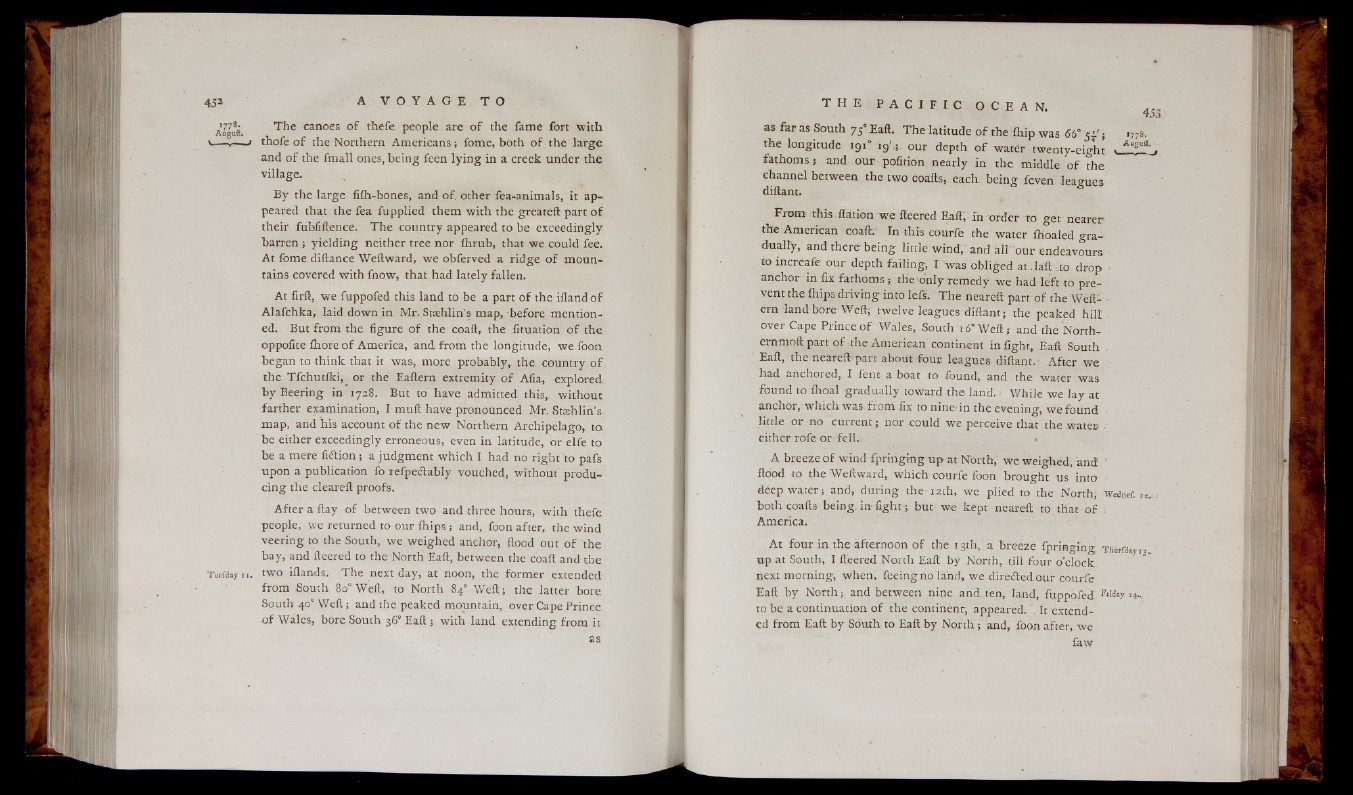
T h e canoes o f thefe people are o f the fame fort w ith
thofe o f the Northern Am er ican s ; fome, both o f the large
and o f the fmall ones, being feen ly in g in a creek under the
village.
By the large fifh-bones, and of. other fea-animals, it appeared
that the fea fupplied them with the greateft part o f
the ir fubfiftence. T h e country appeared to be exceedingly
barren ; y ield in g neither tree nor ihrub, that we could fee.
At fome diftance Weftward, we obferved a rid ge o f mountains
covered with fnow, that had lately fallen.
At M , w e fuppofed this land to be a part o f the ifland o f
Alafehka, laid down in Mr. Staflilin’s map, before mentioned.
But from the figure o f the coaft, the fituation o f the
oppofite ihore o f America, and from the longitude, w e foon
began to think that it was, more probably, the country o f
the Tfchutiki, or the Eaitern extremity o f Afia, explored
b y Beering in 1728. But to have admitted this,, without
farther examination, I muft have pronounced Mr. Stsehlin’s
map, and his account o f the n ew Northern Archipelago, to.
be either exceedingly erroneous, even in latitude, or elfe to
be a mere f iit io n ; a judgment which I had no right to pafs
upon a publication fo re fpe ilab ly vouched, without producin
g the cleared; proofs.
A fte r a flay o f between two and three hours, with thefe
people, we returned to our ih ip s ; and, foon after, the wind
veering to the South, we weighed anchor, flood out o f the
bay, and fleered to the North Eaft, between the coaft and the
two iflands. T he next day, at noon, the former extended
from South 80° Weft, to North 84° W e ft;. the latter bore
South 40° We ft; and the peaked mountain, over Cape Prince
o f Wales, bore South 36° Eaft ; with land extending from it
as
as fa r as South 750 Eaft. T he latitude o f the ihip was 660 54' •
the longitude 191° 19',;. our depth o f water twenty-eight
fathoms -, and our polition nearly in the middle o f the
channel between the two coafts, each being feven leagues
diftant.
From this ffation we fleered Eaft, in order to g e t nearer
the American coaft.' In this courfe the water fhoaled g ra dually,
and there being little wind, and a ll' our endeavours
to increafe o u r depth failin g, I was obliged a t.la ft to drop
anchor in fix fathoms ; the o n ly remedy we had left to prev
en t the ihips d r iv in g into lefs. T h e neareft part o f the Weft-
ern land bore Weft; twelve leagues diftant; the peaked hill
over Cape Prince o f Wales, South I 6' Weft ;• and thé North-
ernmoft part o f .the American continent in fight, Eaft South
Eaft, the neareft-part about fo u r leagues diftant. After w e
had anchored, I fent a boat .to-found, and the water was
found to fhoal grad u ally toward the land. While we la y at
anchor, w hich w as from fix to nine; in the evening, we found
little o r no current ; nor could we perceive that the w a te r .,
either rofe or fe lL
A breeze o f wind fpringmg up at North, we weighed, and: ’
flood to the Weftward, w hich courfe foon brought us into
déep water ; and, during the m h , w e plied to the North, Wednef.
both coafts being, in f ig h t -, b u t w e kept neareft to that o f .
America.
A t four in the afternoon o f the 13th, a breeze fp r ing ing T n a iy , ,
up at South, I fleered North Eaft by North, till four o’c lo ck
next morning, when, feeing no land, we dirëéted our courfe
Eaft b y North ; and between nine and.ten, land, fuppofed FlWay *4-
to be a continuation o f the continent, appeared. . It extended
from Eaft by South to Eaft by No rth; and, foon after, we
law